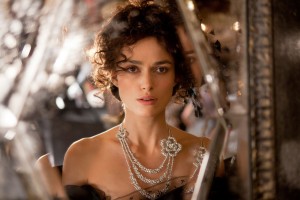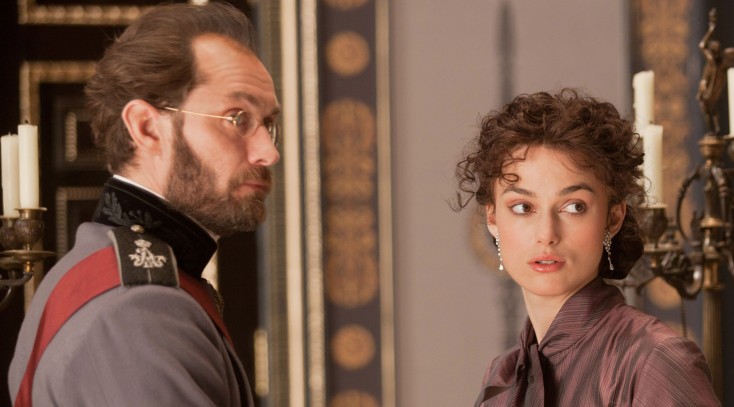
Keira Knightley is the adulterous Anna Karenina in director Joe Wright’s bold new adaptation of the classic novel © 2012 Focus Features CR: Laurie Sparham
By ANGELA DAWSON
Front Row Features
HOLLYWOOD—Martin Scorsese has Leonardo DiCaprio. Ridley Scott has Russell Crowe. Director Joe Wright’s go-to actor is the lovely and versatile Keira Knightley.
The director first cast Knightley as the Jane Austen heroine Elizabeth Bennet in his 2005 drama “Pride & Prejudice.” He cast her again two years later in another period drama, “Atonement,” based on the Ian McEwan novel. Both films were box office hits and received multiple Oscar nominations.
Director and actor pair up again with another adapted literary work, Leo Tolstoy’s “Anna Karenina,” in which Knightley plays the title role. As Anna, Knightley is the reckless and captivating 19th century married Russian socialite whose affair with a dashing cavalry officer named Vronsky (Aaron Taylor-Johnson) proves to be her undoing. The film also stars Jude Law as her cuckold husband Karenin and Matthew Macfadyen, who played her beloved Mr. Darcy in “Pride & Prejudice,” as her brother Oblonsky.
Wright takes a bold theatrical approach with the classic Tolstoy work, giving the viewing audience a more immersive experience than traditional cinematic storytelling.
The 27-year-old actress recently sat down to talk about her newest collaboration with her fellow Brit, and why she keeps coming back to work with him again and again.
Q: What was the most challenging scene or scenes for you?
Knightley: They were all pretty challenging. I think the whole stylized movement aspect of it was very difficult because I had never done anything like that before. There is a soiree where Vronsky (Taylor-Johnson) and Anna flirt, and all of the movement within that was absolutely choreographed. It was something that was quite challenging because I’d never done anything like it.
Q: Did you have to be talked into the idea of having some of the sets appear like those you’d see in a theater production?
Knightley: When we first started talking about it, it was going to be a completely naturalistic telling. Then 10 weeks before we started shooting (Wright) phoned me up and said, “Come around my office, I’ve got something to explain to you.” So I went to his office and he showed me all these sketches and drawings and I thought, “Oh no, here we go.” But I also was incredibly excited because, like I said before, you always know with Joe that he’s going to do something unexpected, and that was it. The theater (imagery) made huge sense. Russian aristocrats at that time often couldn’t speak Russian. They spoke French. They were kind of going through an identity crisis. They dressed in the French style. The houses were built in a French way. They read etiquette books of French. Their ballrooms were lined with mirrors so they could watch themselves performing. So I think this idea of constant performance was something that made a lot of sense. Anna is playing the role of the perfect wife and playing the role of the perfect mother and suddenly she finds that the roles don’t fit.
Q: You’ve worked with CGI in movies like “Pirates of the Caribbean,” but was there anything in the CGI in this that surprised you when you saw the final cut?
Knightley: The whole thing surprised me. Honestly, even when we were making it, we didn’t know how it was going to come together. As an actor, you’re a part of it so you never get to view it from the outside so it’s always a shock when you see it, and this one even more so. How it was all going to come together and whether that concept of the theater was going to work and how it was going to work is something I absolutely didn’t know. This is the only film I’ve every done where I saw it for the first time at the English premiere and immediately thought I’ve got to see it again. There’s so much to take away from it. There is so much to look at and pull out, so that was incredibly exciting but I had no idea what it was going to look like.
Q: Did the choreography involve every scene?
Knightley: We did about three weeks of movement workshops before we started with the choreographer Sidi Larbi Cherkaoui, because Joe (Wright) wanted movement and stylized movement to be a massive part of the film. He saw the whole thing as like a ballet with words. That didn’t just go for our movement but the movement of the camera and the movement of the scenery and everything, and you can see that it really flows into each other. Occasionally, it reaches operatic heights and sort of flows out. So movement was certainly part of it.
Q: There’s a scene where servants are dressing your character but she doesn’t even seem to be aware of what’s going on. What was the thinking behind that?
Knightley: During that period Russian aristocracy did very little for themselves. Servants would dress them and hand them tea. It was a serving class that was mostly ignored but did absolutely everything for these people. I believe Joe thought that was really interesting. So we worked a lot on how exactly that would fluidly work. You’d go to sit down and suddenly there’d be a chair there and somebody’s dressing you or handing you a cup of tea, but you’re not even paying attention. You’re actually doing something else, so it did take a lot of rehearsal. (She laughs.)
Q: Why do you like working with Joe?
Knightley: I think it’s his imagination—it’s totally sensational. Every film we’ve done, you could put them into a category of period films, but they’re really extraordinary pieces on their own. “Pride & Prejudice” wasn’t a generic period film. He really had a vision of it that made it much more realistic and grubby. (The main characters) were quite scruffy and much younger (than previously portrayed). And I think he really had a vision of that story that simply hadn’t been done before. With “Atonement,” that whole Dunkirk (battle) scene was something that was purely from his imagination. And then you get to “Anna Karenina,” and that theatrical imagery is certainly part of his imagination. Because of that, I find him incredibly exciting. You never know where he’s going to go. You know it’s going to be something out of the norm. It’s going to be something that pushes boundaries in some way. He is obsessed by the work that he does. So I think that’s why I like to work with him and I trust him.
Q: Do you think you would have said yes to another director making “Anna Karenina?”
Knightley: I think the alarm bells (for me) would have been ringing, and I would have been going, “Oh, I don’t know if this is going to work.”
Q: How has your working relationship with Joe changed since making “Pride & Prejudice?”
Knightley: We’re friends now. We started off just as colleagues. I know what’s happened in his life. I’ve been there for him through several things, and the same with him for me.
Q: Of the three characters you’ve played in Joe’s films, which has been the toughest?
Knightley: The interesting thing about this is that we really had to grapple with her—Anna Karenina. She’s not a simple creature. She’s a very complex one. It took a lot of discussion and not always agreeing but always completely trusting each other that we wanted the best out of the whole thing.
Q: Was there anything that surprised you about playing Anna?
Knightley: I first read the novel in my late teens or early 20s. I remember Anna as being innocent. I remember the story being beautiful, sweeping, romantic, tragic and all the rest of it, but I also remember her as innocent. When I went back to the book the summer before we started shooting and read it again I went, “this is not how I remember this. She is very different.” I don’t know that innocence comes into it.
Q: Sorry to say this, but I found myself not really liking Anna.
Knightley: That’s good. The function the character plays within the novel and hopefully within this film, you should have quite a complex relationship with her as an audience member or as somebody who reads the book. It’s a kind of process of condemning her, which I think you’re intended to do. I don’t think Tolstoy is holding her up and saying, “Hey everybody, do this.” I think he’s holding her up to be judged and condemned. The terrifying part of her is that you do judge her and you do condemn her and then you go, “Am I any better than her?” And, of course, the answer is no. And that makes it an incredibly interesting relationship with the character.
Q: Do you prefer making period films or contemporary ones?
Knightley: I think it’s all about story. I like the dramatic tool that is fantasy, and I put period films within the category of fantasy, as I would put sci-fi in that same category. As a dramatic tool, it means you leave yourself behind. Your imagination is instantly needed because it’s a world you don’t recognize with rules you don’t know. That means you have a different emotional reaction to the characters. It’s no better or worse than contemporary pieces but contemporary pieces are more about voyeurism. You bring your experiences of life to that piece because you recognize that world. I don’t think you do that as much with the whole fantasy genre and I find that very interesting.
Q: Do the costumes and hair and makeup bring you more into that world?
Knightley: Yeah, because you can put so much symbolism in the costumes of any fantasy. With this one, (the costumes) were a major part of the character. Tolstoy talks of her vanity for many pages so vanity is always within the character of Anna, but equally we saw her as this bird in a cage that couldn’t get out so the cage is in there. The dresses were designed to look like either they were about to fall off or there was lingerie poking through. One of the dresses was actually made with bed fabric so you keep the idea of the post-coital thing within the scene.
Q: Did you have a favorite costume?
Knightley: I think it was the one made of bed sheets. It was the white one and it was crumpled and it was made of sheets so it crumpled like a bed. I wore it quite a few times in the film.





